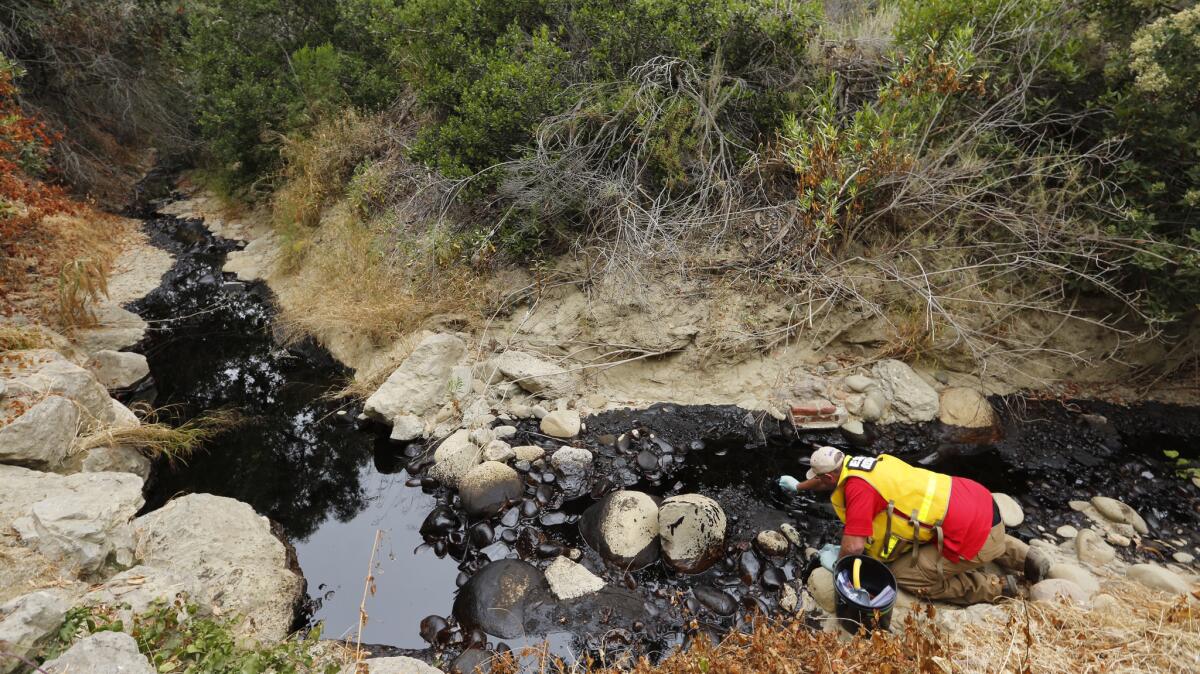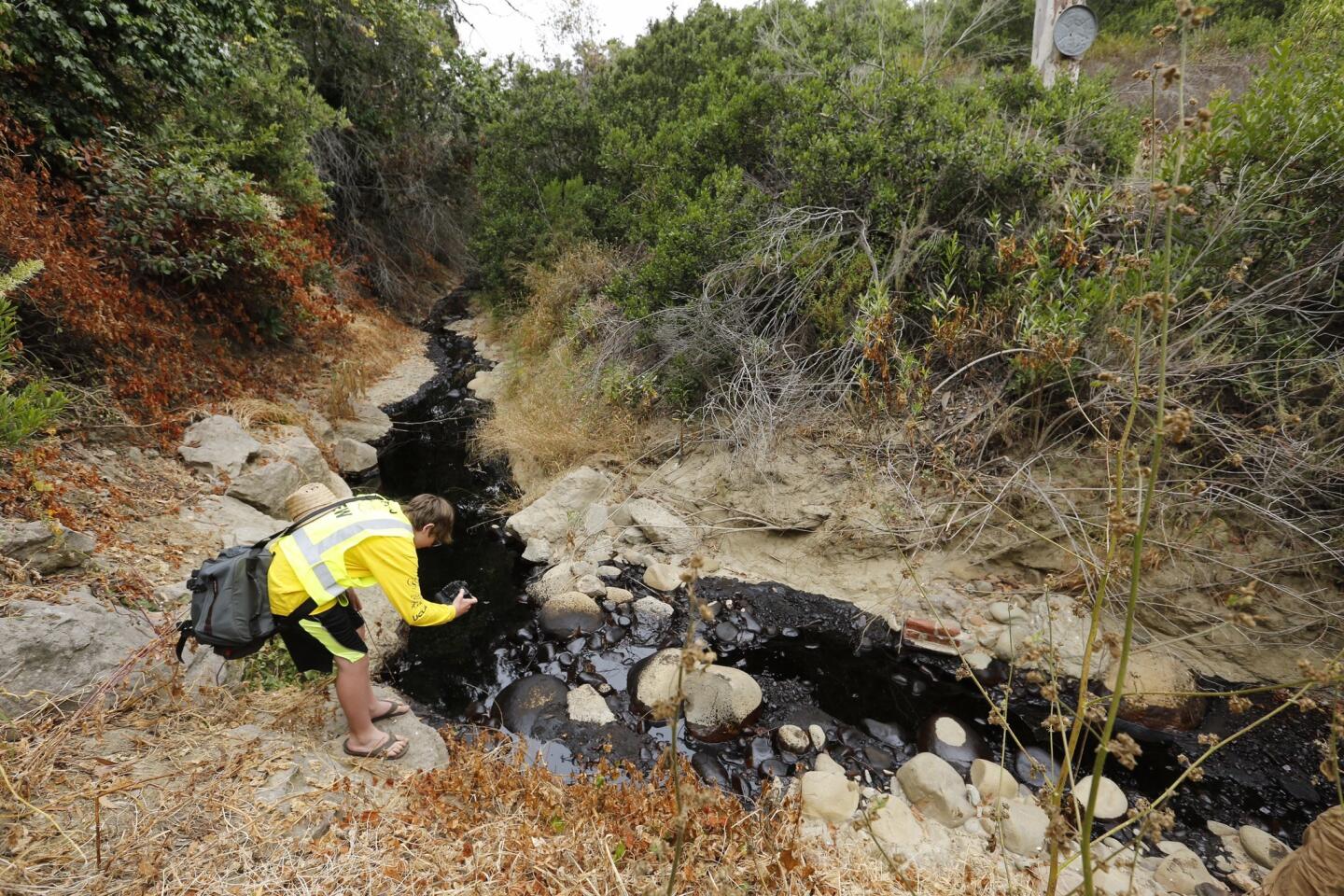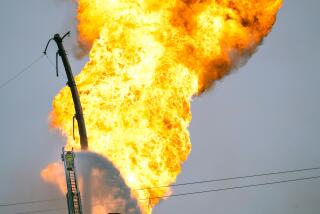Ventura oil spill misses the ocean, but damage on land is unclear

Reporting from Ventura — Before the sun rose Thursday, Kirk Atwater’s wakeup call was a noxious breeze that filled his bedroom with fumes.
He stepped out of his ranch that overlooks an arroyo in the Ventura hills and saw a creek of thick, black goo traveling through the canyon that was dry just the day before.
A pipeline valve had somehow opened and sent thousands of gallons of crude oil down into an arroyo that flows through the city of Ventura and reaches the ocean near the Ventura Pier.
Atwater, 56, called 911 and the oil pipeline company. His early notice helped officials stop the oil in a drainage basin before it reached the ocean, but not before an estimated 29,400 gallons of unrefined crude bled into the canyon.
It marked the latest significant oil spill in California and underscored the hazards of the oil and natural gas industry along the Central Coast, where last year a corroded pipeline spewed 143,000 gallons of crude oil onto Refugio State Beach in Santa Barbara.

An oil spill that may have released more than 29,000 gallons of crude into a grassy canyon in Ventura County did not reach the beach or trigger evacuations. (Al Seib and Mel Melcon / Los Angeles Times)
“There’s no excuse for this happening,” said Henning Ottsen, a 74-year-old engineer who has lived for more than three decades across the canyon from where Thursday’s spill originated. Some of the oil flowed onto his property, coating rocks and foliage with black tar.
“We know the oil fields are back in the hills,” he said. “It should be assured they take care of the infrastructure and not let this sort of thing happen.”
County officials initially estimated that up to 210,000 gallons had flowed out of the pipe, but they later downgraded the figure. The oil flowed down a steep canyon slope and traveled about half a mile through Prince Barranca, a gorge that typically fills with water during storms.
The oil then pooled in a storm water basin, allowing officials to block the crude from flowing farther.
“There’s no way it can get to the ocean,” Ventura County firefighter Marisol Rodriguez said.
Still, residents were concerned that the toxic liquid would harm wildlife. Ottsen, whose ranch and garden sit about 60 feet above the barranca, said he typically sees coyote, deer and mountain lion tracks in the dirt during the mornings.
“It’s a freeway for the animals,” he added.
Capt. George Struble of the state Department of Fish and Wildlife said there were no reports of animals affected.
The cause of the spill is under investigation by a team of state and federal agencies, according to Ventura County Fire Department Capt. Mike Lindbery. Investigators with the state Office of Spill Prevention also arrived to assess the site, an agency spokeswoman said.
Owned by Colorado-based Crimson Pipeline LLC, the 10-inch underground pipeline was installed in 1941 and is up to date on state and federal inspections, according to Kendall Klingler, a spokeswoman for the company.
The pipeline, however, had been undergoing maintenance Wednesday and was not at its full rate of flow or pressure, Klingler said. The valve that was the source of the oil had been replaced Wednesday, she added.
The pipeline company offered a lower estimate of the spill than county officials, saying that no more than 25,200 gallons had been released.
Crimson Pipeline is responsible for the cleanup effort and deployed contractors to lay down large, absorbent booms in the barranca to mop up the crude. On Thursday afternoon, workers in white haz-mat suits hiked down to the canyon with industrial pumps and planned to vacuum the pools of liquid that formed along the riverbed. A caravan of trucks would then haul the liquid away.
Officials could not provide a timetable for the cleanup.
State agencies were working in concert with the pipeline company to monitor the cleanup effort, Klingler said.
Thursday’s spill marked Crimson’s 11th pipeline spill or equipment incident since 2006, according to records compiled by the U.S. Department of Transportation’s Pipeline & Hazardous Materials Safety Administration.
In total, about 313,000 gallons of hazardous liquid have been spilled since 2006, records show. The largest occurred in Ventura in 2008, when equipment failure caused about 280,000 gallons to spill. The most recent occurred in December, when an error during excavation caused more than 8,800 gallons to be released in Somis, Calif.
The company whose pipeline was involved in last year’s spill in Santa Barbara, Plains All American Pipeline, was indicted in May on 46 criminal counts, including four felony charges of knowingly discharging a pollutant into state waters. The Houston company faces fines of nearly $3 million.
That rupture had devastating effects on wildlife in the area: 204 birds and 106 marine mammals died as a result of the spill, according to UC Davis’ Oiled Wildlife Care Network.
The smaller spill in Ventura prompted Mati Waiya, the executive director of Ventura Coastkeeper and the Wishtoyo Foundation, to declare oil pipelines as unsafe sources of pollution.
“The only thing that will stop their negative impact to people, wildlife and waterways is to shut them down and keep fossil fuels in the ground,” Waiya said in a statement.
Officials praised the swift response for averting a more damaging disaster by keeping the crude out of the ocean.
But Atwater, surveying the barranca with a mask covering his mouth and nose to block the pungent odor, was not convinced: “We have a tragedy in my backyard.”
Hamilton reported from Ventura, Serna and Rocha from Los Angeles. Times staff writer Doug Smith contributed to this report.
For breaking California news, follow @JosephSerna.
ALSO
Red flag conditions ahead for Southern California amid several wildfires
‘No bill, no break’: House Democrats continue sit-in protest into early morning
Supreme court deadlock deals defeat to Obama immigration plan
UPDATES:
9:46 p.m.: This article was updated with Crimson saying it believes the spill was smaller than the county estimates.
9:10 p.m.: This article was updated throughout with additional details on the cause and cleanup.
1:28 p.m.: This article was updated with additional background on the pipeline company.
11:28 a.m.: This article was updated with new details from officials.
10:18 a.m.: This article was updated with reaction from an environmental group.
9:25 a.m.: This article was updated with new information.
8:36 a.m.: This article was updated with state regulators heading to the incident.
8:13 a.m.: This article was updated with additional information about Aera Energy.
This article was originally published at 7:56 a.m.
More to Read
Sign up for Essential California
The most important California stories and recommendations in your inbox every morning.
You may occasionally receive promotional content from the Los Angeles Times.













